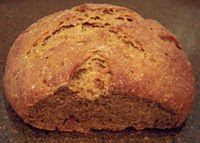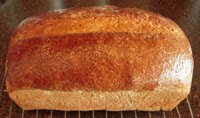
I've mentioned a couple of time that I use a cloche or Romertopf lid frequently in baking. If you are interested, here is a brief description of what I do. If you are unfamiliar with it, a cloche is an unglazed stoneware dish with a bell-shaped lid (as shown in the first picture). Dating back to early Greeks and Romans, traditionally, it was used as a portable oven. Food was placed in the dish to bake, covered, and the embers were placed around the cloche. A cloche can be used for any form of baking, not just breads.
The cloche shown in the picture is a Superstone(r) La Cloche that's I had for years. Typically, the loaf is place in a dry cloche at room temperature and then the cloche is place in a hot oven. However, this is not what I do. Inspired by a demonstration by Lionel Vatinet at the Asheville Bread Festival a couple of years ago, I now pre-soak the lid. That is, I fill it with water and let it sit for 15 minutes or so as the oven, with a pizza stone, preheats. I carefully drain the water from the lid, place the loaf on the pizza stone, and then cover it with the lid and close the oven. (I do not use the bottom of the cloche.) After about 10 or 15 minutes, I carefully remove the lid and allow the loaf to finish baking.
CAUTION! You need to be very careful when removing the lid because a lot of steam and water vapor will be released from under the lid when you remove it. It is very, very easy to get a nasty burn if you aren't careful. Having a handle on the lid is a real convenience!

If you don't have a cloche or if you are working with a longer loaf, you can substitute a Romertopf lid for for the cloche lid. I use the cloche lid for boules and the Romertopf lid for bâtards. When working with the Romertopf lid, however, it is much more difficult to remove the lid from the baking stone safely. I slide the lid slightly to one side so it overhangs the edge of the stone, and I'm very careful to keep something between me and the escaping steam and water vapor.
Why bother? The cloche or Romertopf lid provides a micro-environment with a very large amount of steam. With this approach, I get much better results than I've ever gotten with the other approaches at generating steam, be it a cast iron pan filled with boiling water or ice on the floor of the oven. Indeed, there is no point in bothering with any of these other approaches if you are covering the bread with a cloche or Romertopf lid.
With this approach, you'll get a great oven spring. In fact, you need to be very careful. If you have a large loaf to begin with, it may expand enough so that it sticks to the lid!
Is the soaking really necessary? I don't really know. I've baked a second loaf following a first without resoaking the lid (for fear the hot lid would shatter if I tried to soak it), and it didn't seem to make much difference. I've also replace the lid once with a disposable foil pan when the loaf was clearly too big to fit under either of the lids I own. This is something I have heard about from others and it also seemed to work fine. But I already own both the cloche and the Romertopf so I've stuck with what I know works. But perhaps I play around with alternatives in the future. Stayed tuned.
 These are three very similar recipes, varying only slightly in terms of flavoring and shaping. According to the original schedule, we were to select one of the three. But, since the recipe makes three small loaves, I decided to make one of each. My strategy was to mix the dough with out the flavorings, cardamon for the jutekage, almond extract for the stollen and orange extract for the panettone. I then added the flavoring to the mixed dough after dividing it into three portions. This strategy worked well with the stollen and panettone, but the cardamon was a bit sharp tasting in the jutekage.
These are three very similar recipes, varying only slightly in terms of flavoring and shaping. According to the original schedule, we were to select one of the three. But, since the recipe makes three small loaves, I decided to make one of each. My strategy was to mix the dough with out the flavorings, cardamon for the jutekage, almond extract for the stollen and orange extract for the panettone. I then added the flavoring to the mixed dough after dividing it into three portions. This strategy worked well with the stollen and panettone, but the cardamon was a bit sharp tasting in the jutekage. 




































